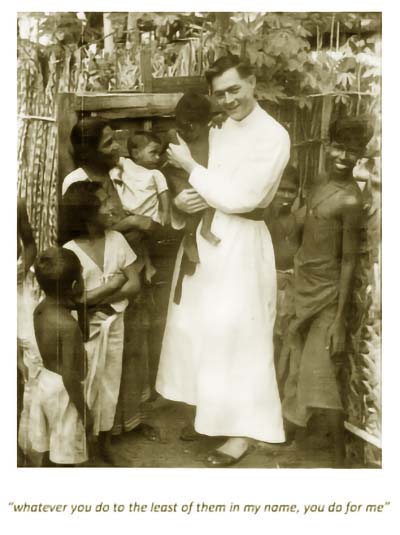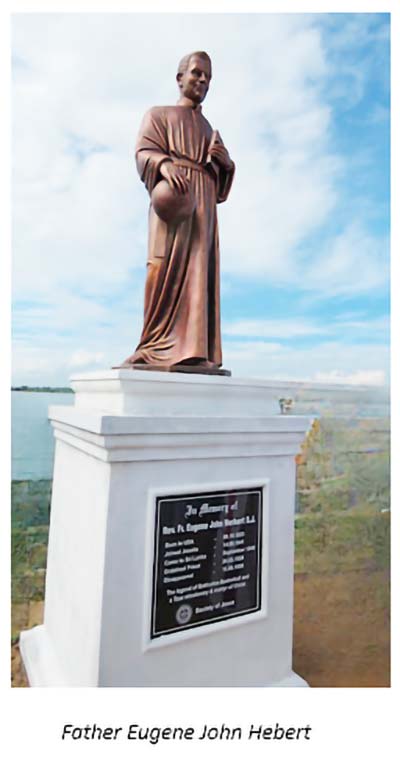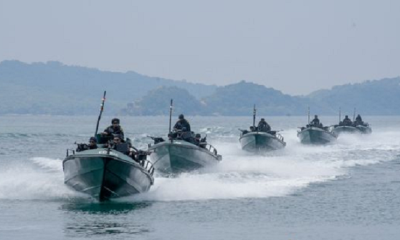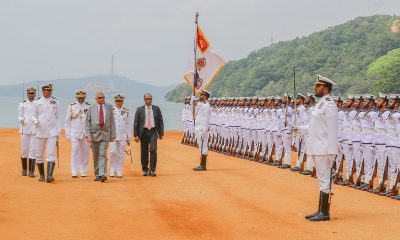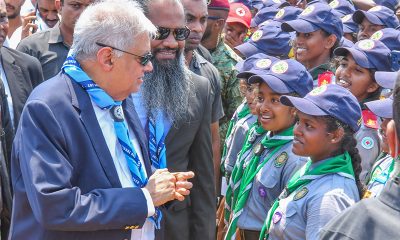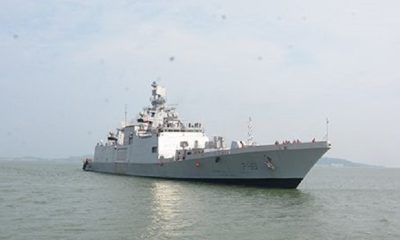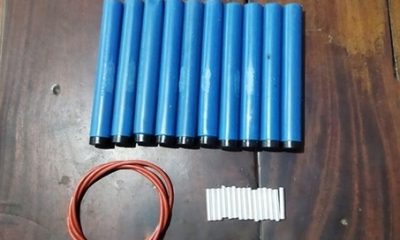Features
Fr Eugene J Hebert – a life to be remembered
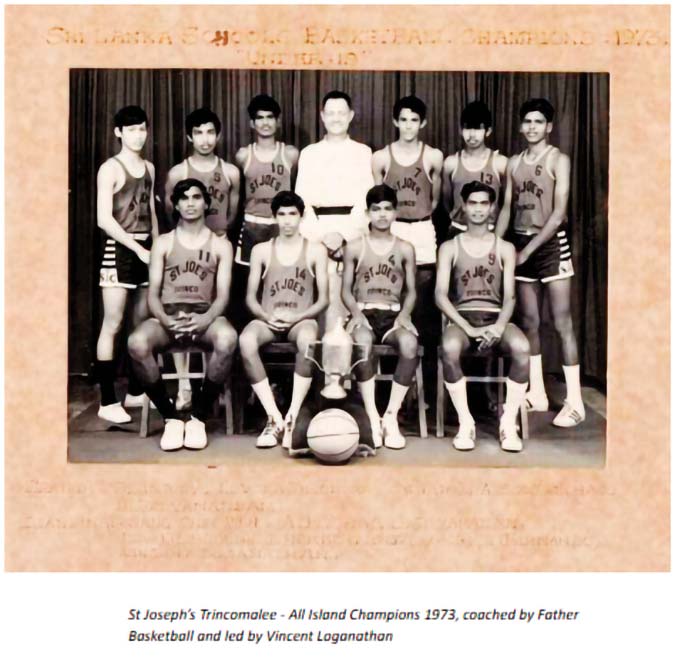
by Capt Elmo Jayawardena
The monument with engraved details of someone stands like a sentinel. It can be seen by anyone entering Batticaloa town from the lagoon-side. At the Garden Park some faithful followers had erected the statue and painted in colours of haunting old gold. It is to honour a priest who no longer walks this planet due to a senseless incident.
The figure is clad in a flowing ankle length robe. The sculpted face is familiar to those who had known him. His signature ghost of a smile is depicted correctly is what anyone who knew him would say. On the left hand, the statue holds a Holy Bible. On the right hand is a basketball, cradled fondly to tell the world the man and the game were synonymous.
It whispers in all simplicity whose statue it is – a dedicated missionary who served the ‘least of them’ for a lifetime. On the flipside he was a coach, by all standards a lover of basketball, and undoubtedly the godfather of the game in the Eastern Province. Father Eugene John Hebert was born 100 years ago, on October 9, 1923. He hailed from the outskirts of Louisiana from the small town of Jennings.
At the age of 25-years, he arrived in Sri Lanka (then Ceylon) in the September of 1948. During that time, there were more than a dozen American Jesuit Missionaries working in the North and East of the island, mainly covering Trincomalee and Batticaloa. The novice Hebert was attached to the St. Sebestian’s Orphanage, Kallady. He then went to India and was ordained as a full-fledged Jesuit priest in 1954.
Yes, the young man was committed with deep faith to serve his fellow beings, and endeared himself deep into the souls of the people in the north and east. He taught and assisted them in all possible ways to uplift their living standards. These were poor people, continuously straddled with limited resources and fewer solutions. Father Hebert did muster the best of his abilities to preach solace and sanity, especially to those in his congregation who lived below the proverbial poverty line.
The Bible that is carried on the left hand of the Garden Park statue is for us to remember the priestly side of Father Hebert. The right hand treasures a basketball! Anybody in Sri Lanka who had anything to do with the game from the sixies onwards would know Father Hebert. He was the best trainer and team handler I saw in local basketball games. Rival coaches feared him, the whistle blowers were scared of him, the players all learned from him, and the spectators loved him.
No wonder he was fondly known as ‘Father Basketball’, and remembered to this day with awe as an unforgettable gladiator in the cager fraternity. Yes, I am glad that along with the Bible, the statue also carries a basketball. Doesn’t that say it all?
I first met Father Hebert in 1963 at the All-Island Schools Basketball Championship in Batticaloa. I was a player for St Sebastian’s and Father Hebert came from Trincomalee with a team from St Joseph’s College. I still remember some of Father Hebert’s players, Anton Nadarajah, Godfrey Tissaveerasinghe and Bimal Thambiah. They did not win the championship but won many hearts playing a different brand of basketball that Father Hebert had taught them to play.
The team was young, and it was the fighting spirit that was in them that astounded everyone who saw them play. It was all their coach’s work; it was Father Hebert who made them play like little demons on the court. I saw the Trinco Boys come again to Moratuwa in 1965 and win the All-Island championship. This time Father Hebert’s team was unbeatable. I do recall Tsang Shi Wang, Freddy Walsh, Joseph Christie and Vasantharaj. The others I forget, it was a long time ago. The team played excellent basketball whilst Father Hebert was on full volume with his ‘fog horn’ voice running the game from the sidelines.
The Trinco Josephians went home as champions. Father Hebert certainly deserved that victory. It was only the beginning. His teams continued to play attractive basketball and won many championships. St Joseph’s Trincomalee – All Island Champions 1973, coached by Father Basketball and led by Vincent Loganathan
My meetings with Father Hebert after that were on the opposite benches of the court when we were rival coaches. I was coaching Moratuwa, and he was coaching Batticaloa. We played against each other in many school matches, and at the Nationals where he coached Eastern Province, and I coached the Mercantile team. I did win some against him. But on the total tally he beat me hands down.
Losing to the ‘Father Basketball’ was no shame and winning against any team he coached was certainly a laudable hallmark victory. Pronouncing Father Hebert’s name was a problem to most as it had originated in the French Quarter of New Orleans and had a Creole twist to it. It was not pronounced as the usual Hebert. He sorted that out in a simple manner. On his desk was a little fluffy bear and the letter ‘A’ in front of it. Anyone who came to his office and called him Father Hebert was told politely the correct pronunciation. “Just read the A and the bear, my name is Abear – not Hebert”, he laughingly said.
What was so great about Father Abear’s coaching? He was excellent in teaching the fundamentals of basketball. He never had height advantage when compared to opposing players, but he had teams that fought from the beginning to the very end. They did not know how to give up. His ‘time-outs’ were precise, and his substitutions were meticulous, quite often they were possible game changers.
Anything he did as a coach was wrapped in strategy. Father Abear was definitely a master tactician in getting the best from his team. The coaching Pardre mostly played zone defenses and seldom shifted to a ‘man-to-man’. That too, it was the age old ‘3/2 zones’ he used, which allowed his boys to move out fast when they got the ball. His attacks were based mainly on speed. “Pull the guard and pass the ball” was his clarion call.
He also did his best to train his players to be ambidextrous. “Your girlfriend should not know whether you are a righty or a lefty”, such was the minted wisdom of words from Father Abear. He certainly had a sense of humour to suit the mood. What I wrote so far was basketball and details of this magnificent man. They were facts I knew. Now I will write what I have gathered about the gruesome happening on the sad day in August 1990.
I thank all those who helped me to gather whatever possible information of an excruciatingly sad story. Who knows what really happened? All I know is Father Abear is no more and that is tragic enough, without me trying to stir the controversial ethnic cauldron. Father Eugene John Hebert The world got older, and things changed for the worse in the 80s. Basketball took a backseat in Sri Lanka when the country went up in flames.
Among the maimed, the missing and the dead were the innocent who had no part in the fighting. Such was the painful reality, irrespective of which racial label they carried, or what god they worshipped. This was a time when friends became foes for no possible reason and orphaned children lit candles in remembrance. The blackest of them all were the mounds of swollen earth which covered the unknown fallen in unmarked graves, lost and forever forgotten. “whatever you do to the least of them in my name, you do for me”
On August 15, 1990, Father Abear had gone to Valaichchenai to attend to some conflict resolution and was returning to Batticaloa via Eravur. He was riding his red Vespa scooter and on the pillion he had Bertram Francis, one of his students. It was past dusk, and the road and the scrub jungle were cloaked in darkness. They were seen at a checkpoint they passed and that was the last time anyone saw Father Abear and Bertram Francis and their scooter.
There’s sure to be those who know how Father Abear and Bertram Francis disappeared. ‘The powers that were’ at that time and the nuclear superior American Embassy should take some share for the silence. After all, to them, it was only an ageing missionary from Louisiana and a young Tamil boy from Batticaloa. They were the innocent expendables. There is no trace of the truth. It seems to have scattered and blown away by the winds of the Northeastern monsoon.
Impossible to decipher after 33 years. It is doubtful whether anyone will ever know what really happened? The times were agonizing and traumatic. I do not know the details except what I heard and read regarding Father Abear’s and Bertram Francis’ disappearance. Somewhere between Valaichchenai and Batticaloa they simply vanished. Such incidents were not uncommon, just tragically sad and horrendously meaningless. “They shall grow not old, as we that are left grow old. Age shall not weary them, nor the years condemn. At the going down of the sun and in the morning we shall remember them.”
His 100-year birth anniversary is here. We will crisscross emails and send text messages and phone each other, to walk down our own basketball memory lanes to talk about Father Abear. To live in the hearts of those you leave behind, is but, surely not to die. I sincerely hope those I reach with this appreciation will pass it to others and remember the indomitable Eugene John Hebert or simply Father Abear, who stands forever on a pedestal in the lagoon Garden Park looking at his beloved Batticaloa.
So long Father Abear; sometimes I wonder whether you were ever aware how much we respected you.
elmojay1@gmail.com
Features
The heart-friendly health minister

by Dr Gotabhya Ranasinghe
Senior Consultant Cardiologist
National Hospital Sri Lanka
When we sought a meeting with Hon Dr. Ramesh Pathirana, Minister of Health, he graciously cleared his busy schedule to accommodate us. Renowned for his attentive listening and deep understanding, Minister Pathirana is dedicated to advancing the health sector. His openness and transparency exemplify the qualities of an exemplary politician and minister.
Dr. Palitha Mahipala, the current Health Secretary, demonstrates both commendable enthusiasm and unwavering support. This combination of attributes makes him a highly compatible colleague for the esteemed Minister of Health.
Our discussion centered on a project that has been in the works for the past 30 years, one that no other minister had managed to advance.
Minister Pathirana, however, recognized the project’s significance and its potential to revolutionize care for heart patients.
The project involves the construction of a state-of-the-art facility at the premises of the National Hospital Colombo. The project’s location within the premises of the National Hospital underscores its importance and relevance to the healthcare infrastructure of the nation.
This facility will include a cardiology building and a tertiary care center, equipped with the latest technology to handle and treat all types of heart-related conditions and surgeries.
Securing funding was a major milestone for this initiative. Minister Pathirana successfully obtained approval for a $40 billion loan from the Asian Development Bank. With the funding in place, the foundation stone is scheduled to be laid in September this year, and construction will begin in January 2025.
This project guarantees a consistent and uninterrupted supply of stents and related medications for heart patients. As a result, patients will have timely access to essential medical supplies during their treatment and recovery. By securing these critical resources, the project aims to enhance patient outcomes, minimize treatment delays, and maintain the highest standards of cardiac care.
Upon its fruition, this monumental building will serve as a beacon of hope and healing, symbolizing the unwavering dedication to improving patient outcomes and fostering a healthier society.We anticipate a future marked by significant progress and positive outcomes in Sri Lanka’s cardiovascular treatment landscape within the foreseeable timeframe.
Features
A LOVING TRIBUTE TO JESUIT FR. ALOYSIUS PIERIS ON HIS 90th BIRTHDAY

by Fr. Emmanuel Fernando, OMI
Jesuit Fr. Aloysius Pieris (affectionately called Fr. Aloy) celebrated his 90th birthday on April 9, 2024 and I, as the editor of our Oblate Journal, THE MISSIONARY OBLATE had gone to press by that time. Immediately I decided to publish an article, appreciating the untiring selfless services he continues to offer for inter-Faith dialogue, the renewal of the Catholic Church, his concern for the poor and the suffering Sri Lankan masses and to me, the present writer.
It was in 1988, when I was appointed Director of the Oblate Scholastics at Ampitiya by the then Oblate Provincial Fr. Anselm Silva, that I came to know Fr. Aloy more closely. Knowing well his expertise in matters spiritual, theological, Indological and pastoral, and with the collaborative spirit of my companion-formators, our Oblate Scholastics were sent to Tulana, the Research and Encounter Centre, Kelaniya, of which he is the Founder-Director, for ‘exposure-programmes’ on matters spiritual, biblical, theological and pastoral. Some of these dimensions according to my view and that of my companion-formators, were not available at the National Seminary, Ampitiya.
Ever since that time, our Oblate formators/ accompaniers at the Oblate Scholasticate, Ampitiya , have continued to send our Oblate Scholastics to Tulana Centre for deepening their insights and convictions regarding matters needed to serve the people in today’s context. Fr. Aloy also had tried very enthusiastically with the Oblate team headed by Frs. Oswald Firth and Clement Waidyasekara to begin a Theologate, directed by the Religious Congregations in Sri Lanka, for the contextual formation/ accompaniment of their members. It should very well be a desired goal of the Leaders / Provincials of the Religious Congregations.
Besides being a formator/accompanier at the Oblate Scholasticate, I was entrusted also with the task of editing and publishing our Oblate journal, ‘The Missionary Oblate’. To maintain the quality of the journal I continue to depend on Fr. Aloy for his thought-provoking and stimulating articles on Biblical Spirituality, Biblical Theology and Ecclesiology. I am very grateful to him for his generous assistance. Of late, his writings on renewal of the Church, initiated by Pope St. John XX111 and continued by Pope Francis through the Synodal path, published in our Oblate journal, enable our readers to focus their attention also on the needed renewal in the Catholic Church in Sri Lanka. Fr. Aloy appreciated very much the Synodal path adopted by the Jesuit Pope Francis for the renewal of the Church, rooted very much on prayerful discernment. In my Religious and presbyteral life, Fr.Aloy continues to be my spiritual animator / guide and ongoing formator / acccompanier.
Fr. Aloysius Pieris, BA Hons (Lond), LPh (SHC, India), STL (PFT, Naples), PhD (SLU/VC), ThD (Tilburg), D.Ltt (KU), has been one of the eminent Asian theologians well recognized internationally and one who has lectured and held visiting chairs in many universities both in the West and in the East. Many members of Religious Congregations from Asian countries have benefited from his lectures and guidance in the East Asian Pastoral Institute (EAPI) in Manila, Philippines. He had been a Theologian consulted by the Federation of Asian Bishops’ Conferences for many years. During his professorship at the Gregorian University in Rome, he was called to be a member of a special group of advisers on other religions consulted by Pope Paul VI.
Fr. Aloy is the author of more than 30 books and well over 500 Research Papers. Some of his books and articles have been translated and published in several countries. Among those books, one can find the following: 1) The Genesis of an Asian Theology of Liberation (An Autobiographical Excursus on the Art of Theologising in Asia, 2) An Asian Theology of Liberation, 3) Providential Timeliness of Vatican 11 (a long-overdue halt to a scandalous millennium, 4) Give Vatican 11 a chance, 5) Leadership in the Church, 6) Relishing our faith in working for justice (Themes for study and discussion), 7) A Message meant mainly, not exclusively for Jesuits (Background information necessary for helping Francis renew the Church), 8) Lent in Lanka (Reflections and Resolutions, 9) Love meets wisdom (A Christian Experience of Buddhism, 10) Fire and Water 11) God’s Reign for God’s poor, 12) Our Unhiddden Agenda (How we Jesuits work, pray and form our men). He is also the Editor of two journals, Vagdevi, Journal of Religious Reflection and Dialogue, New Series.
Fr. Aloy has a BA in Pali and Sanskrit from the University of London and a Ph.D in Buddhist Philosophy from the University of Sri Lankan, Vidyodaya Campus. On Nov. 23, 2019, he was awarded the prestigious honorary Doctorate of Literature (D.Litt) by the Chancellor of the University of Kelaniya, the Most Venerable Welamitiyawe Dharmakirthi Sri Kusala Dhamma Thera.
Fr. Aloy continues to be a promoter of Gospel values and virtues. Justice as a constitutive dimension of love and social concern for the downtrodden masses are very much noted in his life and work. He had very much appreciated the commitment of the late Fr. Joseph (Joe) Fernando, the National Director of the Social and Economic Centre (SEDEC) for the poor.
In Sri Lanka, a few religious Congregations – the Good Shepherd Sisters, the Christian Brothers, the Marist Brothers and the Oblates – have invited him to animate their members especially during their Provincial Congresses, Chapters and International Conferences. The mainline Christian Churches also have sought his advice and followed his seminars. I, for one, regret very much, that the Sri Lankan authorities of the Catholic Church –today’s Hierarchy—- have not sought Fr.
Aloy’s expertise for the renewal of the Catholic Church in Sri Lanka and thus have not benefited from the immense store of wisdom and insight that he can offer to our local Church while the Sri Lankan bishops who governed the Catholic church in the immediate aftermath of the Second Vatican Council (Edmund Fernando OMI, Anthony de Saram, Leo Nanayakkara OSB, Frank Marcus Fernando, Paul Perera,) visited him and consulted him on many matters. Among the Tamil Bishops, Bishop Rayappu Joseph was keeping close contact with him and Bishop J. Deogupillai hosted him and his team visiting him after the horrible Black July massacre of Tamils.
Features
A fairy tale, success or debacle

Sri Lanka-Singapore Free Trade Agreement
By Gomi Senadhira
senadhiragomi@gmail.com
“You might tell fairy tales, but the progress of a country cannot be achieved through such narratives. A country cannot be developed by making false promises. The country moved backward because of the electoral promises made by political parties throughout time. We have witnessed that the ultimate result of this is the country becoming bankrupt. Unfortunately, many segments of the population have not come to realize this yet.” – President Ranil Wickremesinghe, 2024 Budget speech
Any Sri Lankan would agree with the above words of President Wickremesinghe on the false promises our politicians and officials make and the fairy tales they narrate which bankrupted this country. So, to understand this, let’s look at one such fairy tale with lots of false promises; Ranil Wickremesinghe’s greatest achievement in the area of international trade and investment promotion during the Yahapalana period, Sri Lanka-Singapore Free Trade Agreement (SLSFTA).
It is appropriate and timely to do it now as Finance Minister Wickremesinghe has just presented to parliament a bill on the National Policy on Economic Transformation which includes the establishment of an Office for International Trade and the Sri Lanka Institute of Economics and International Trade.
Was SLSFTA a “Cleverly negotiated Free Trade Agreement” as stated by the (former) Minister of Development Strategies and International Trade Malik Samarawickrama during the Parliamentary Debate on the SLSFTA in July 2018, or a colossal blunder covered up with lies, false promises, and fairy tales? After SLSFTA was signed there were a number of fairy tales published on this agreement by the Ministry of Development Strategies and International, Institute of Policy Studies, and others.
However, for this article, I would like to limit my comments to the speech by Minister Samarawickrama during the Parliamentary Debate, and the two most important areas in the agreement which were covered up with lies, fairy tales, and false promises, namely: revenue loss for Sri Lanka and Investment from Singapore. On the other important area, “Waste products dumping” I do not want to comment here as I have written extensively on the issue.
1. The revenue loss
During the Parliamentary Debate in July 2018, Minister Samarawickrama stated “…. let me reiterate that this FTA with Singapore has been very cleverly negotiated by us…. The liberalisation programme under this FTA has been carefully designed to have the least impact on domestic industry and revenue collection. We have included all revenue sensitive items in the negative list of items which will not be subject to removal of tariff. Therefore, 97.8% revenue from Customs duty is protected. Our tariff liberalisation will take place over a period of 12-15 years! In fact, the revenue earned through tariffs on goods imported from Singapore last year was Rs. 35 billion.
The revenue loss for over the next 15 years due to the FTA is only Rs. 733 million– which when annualised, on average, is just Rs. 51 million. That is just 0.14% per year! So anyone who claims the Singapore FTA causes revenue loss to the Government cannot do basic arithmetic! Mr. Speaker, in conclusion, I call on my fellow members of this House – don’t mislead the public with baseless criticism that is not grounded in facts. Don’t look at petty politics and use these issues for your own political survival.”
I was surprised to read the minister’s speech because an article published in January 2018 in “The Straits Times“, based on information released by the Singaporean Negotiators stated, “…. With the FTA, tariff savings for Singapore exports are estimated to hit $10 million annually“.
As the annual tariff savings (that is the revenue loss for Sri Lanka) calculated by the Singaporean Negotiators, Singaporean $ 10 million (Sri Lankan rupees 1,200 million in 2018) was way above the rupees’ 733 million revenue loss for 15 years estimated by the Sri Lankan negotiators, it was clear to any observer that one of the parties to the agreement had not done the basic arithmetic!
Six years later, according to a report published by “The Morning” newspaper, speaking at the Committee on Public Finance (COPF) on 7th May 2024, Mr Samarawickrama’s chief trade negotiator K.J. Weerasinghehad had admitted “…. that forecasted revenue loss for the Government of Sri Lanka through the Singapore FTA is Rs. 450 million in 2023 and Rs. 1.3 billion in 2024.”
If these numbers are correct, as tariff liberalisation under the SLSFTA has just started, we will pass Rs 2 billion very soon. Then, the question is how Sri Lanka’s trade negotiators made such a colossal blunder. Didn’t they do their basic arithmetic? If they didn’t know how to do basic arithmetic they should have at least done their basic readings. For example, the headline of the article published in The Straits Times in January 2018 was “Singapore, Sri Lanka sign FTA, annual savings of $10m expected”.
Anyway, as Sri Lanka’s chief negotiator reiterated at the COPF meeting that “…. since 99% of the tariffs in Singapore have zero rates of duty, Sri Lanka has agreed on 80% tariff liberalisation over a period of 15 years while expecting Singapore investments to address the imbalance in trade,” let’s turn towards investment.
Investment from Singapore
In July 2018, speaking during the Parliamentary Debate on the FTA this is what Minister Malik Samarawickrama stated on investment from Singapore, “Already, thanks to this FTA, in just the past two-and-a-half months since the agreement came into effect we have received a proposal from Singapore for investment amounting to $ 14.8 billion in an oil refinery for export of petroleum products. In addition, we have proposals for a steel manufacturing plant for exports ($ 1 billion investment), flour milling plant ($ 50 million), sugar refinery ($ 200 million). This adds up to more than $ 16.05 billion in the pipeline on these projects alone.
And all of these projects will create thousands of more jobs for our people. In principle approval has already been granted by the BOI and the investors are awaiting the release of land the environmental approvals to commence the project.
I request the Opposition and those with vested interests to change their narrow-minded thinking and join us to develop our country. We must always look at what is best for the whole community, not just the few who may oppose. We owe it to our people to courageously take decisions that will change their lives for the better.”
According to the media report I quoted earlier, speaking at the Committee on Public Finance (COPF) Chief Negotiator Weerasinghe has admitted that Sri Lanka was not happy with overall Singapore investments that have come in the past few years in return for the trade liberalisation under the Singapore-Sri Lanka Free Trade Agreement. He has added that between 2021 and 2023 the total investment from Singapore had been around $162 million!
What happened to those projects worth $16 billion negotiated, thanks to the SLSFTA, in just the two-and-a-half months after the agreement came into effect and approved by the BOI? I do not know about the steel manufacturing plant for exports ($ 1 billion investment), flour milling plant ($ 50 million) and sugar refinery ($ 200 million).
However, story of the multibillion-dollar investment in the Petroleum Refinery unfolded in a manner that would qualify it as the best fairy tale with false promises presented by our politicians and the officials, prior to 2019 elections.
Though many Sri Lankans got to know, through the media which repeatedly highlighted a plethora of issues surrounding the project and the questionable credentials of the Singaporean investor, the construction work on the Mirrijiwela Oil Refinery along with the cement factory began on the24th of March 2019 with a bang and Minister Ranil Wickremesinghe and his ministers along with the foreign and local dignitaries laid the foundation stones.
That was few months before the 2019 Presidential elections. Inaugurating the construction work Prime Minister Ranil Wickremesinghe said the projects will create thousands of job opportunities in the area and surrounding districts.
The oil refinery, which was to be built over 200 acres of land, with the capacity to refine 200,000 barrels of crude oil per day, was to generate US$7 billion of exports and create 1,500 direct and 3,000 indirect jobs. The construction of the refinery was to be completed in 44 months. Four years later, in August 2023 the Cabinet of Ministers approved the proposal presented by President Ranil Wickremesinghe to cancel the agreement with the investors of the refinery as the project has not been implemented! Can they explain to the country how much money was wasted to produce that fairy tale?
It is obvious that the President, ministers, and officials had made huge blunders and had deliberately misled the public and the parliament on the revenue loss and potential investment from SLSFTA with fairy tales and false promises.
As the president himself said, a country cannot be developed by making false promises or with fairy tales and these false promises and fairy tales had bankrupted the country. “Unfortunately, many segments of the population have not come to realize this yet”.
(The writer, a specialist and an activist on trade and development issues . )

